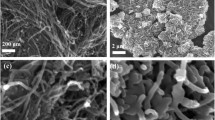Abstract
The migration of the discharge products of polysulfide in the lithium-sulfur batteries inhibits their practical application. In addition, the poor electron transport also limits the specific capacity of the element sulfur. Therefore, these two problems must be solved to achieve the high electrochemical performance of the lithium-sulfur batteries. Herein, we prepared NiCo2O4 materials via a facile method and designed it as the sulfur host materials in the lithium-sulfur batteries. The as-prepared NiCo2O4/S (NCO/S) composites showed excellent ability to stabilize the discharge products of the soluble polysulfide. Also, the NCO/S composites exhibit high electronic conductivity compared to the pure S cathode. As a result, the as-prepared NCO/S composites display high specific capacity and superior cycling stability.





Similar content being viewed by others
References
Xu N, Qian T, Liu XJ, Liu J, Chen Y, Yan CL (2017) Greatly suppressed shuttle effect for improved lithium sulfur battery performance through short chain intermediates. Nano Lett 17:538–543
Fan Q, Liu W, Weng Z, Sun YM, Wang HL (2015) Ternary hybrid material for high-performance lithium–sulfur battery. J Am Chem Soc 137:12946–12953
Li L, Wu ZP, Sun H, Chen DM, Gao J, Suresh S, Chow P, Singh CV, Koratkar N (2015) A Foldable Lithium-Sulfur Battery. ACS Nano 9:11342–11350
Shi LW, Cheng MM, Zhang WQ, Hou SF, Hu C (2021) Fe-doped Ni(OH)2 nanosheets grown on carbon fiber cloths as cathode interlayers for high-performance lithium-sulfur batteries. Mater. Lett. 301:130332
Wu F, Ye YS, Chen RJ, Qian J, Zhao T, Li L, Li WH (2015) Systematic effect for an ultralong cycle lithium–sulfur battery. Nano Lett 15:7431–7439
Lo YH, Kuo PL, Wu JJ (2021) Direct coating of multifunctional zinc oxide-reduced graphene oxide interlayer on cathode for lithium-sulfur batteries. Electrochim Acta 382:138270
Du Y, Huang RK, Lin XD, Khan S, Zheng BN, Fu RW (2020) Template-free preparation of hierarchical porous carbon nanosheets for lithium–sulfur battery. Langmuir 36:14507–14513
Zheng SN, Sun DL, Wu LL, Liu SM, Liu GH (2021) Carbon fiber supported two-dimensional ZIF-7 interlayer for durable lithium-sulfur battery. J Alloys Compd 870:159412
Li Z, Han Y, Wei JH, Wang WQ, Cao TT, Xu SM, Xu ZH (2017) Suppressing shuttle effect using janus cation exchange membrane for high-performance lithium–sulfur battery separator. ACS Appl Mater Interfaces 9:44776–44781
Ahn H, Kim Y, Bae J, Kim YK, Kim WB (2020) A multifunctional SnO2-nanowires/carbon composite interlayer for high-performance lithium-sulfur batteries. Chem Eng J 401:126042
Liu S, Li GR, Gao XP (2016) Lanthanum nitrate as electrolyte additive to stabilize the surface morphology of lithium anode for lithium–sulfur battery. ACS Appl Mater Interfaces 8:7783–7789
Zheng BB, Yu LH, Li NR, Xi JY (2020) Efficiently immobilizing and converting polysulfide by a phosphorus doped carbon microtube textile interlayer for high-performance lithium-sulfur batteries. Electrochim Acta 345:136186
Guo JC, Yang ZC, Yu YC, Abruna HD, Archer LA (2013) Lithium–sulfur battery cathode enabled by lithium–nitrile interaction. J Am Chem Soc 135:763–767
Sun ZH, Guo YP, Li BE, Tan TZ, Zhao Y (2019) ZnO/carbon nanotube/reduced graphene oxide composite film as an effective interlayer for lithium/sulfur batteries. Solid State Sci 95:105924
Chen CF, Mistry A, Mukherjee PP (2017) Probing impedance and microstructure evolution in lithium–sulfur battery electrodes. J Phys Chem C 121:21206–21216
Jin Q, Li L, Wang HR, Gao H, Zhu CC, Zhang XT (2019) Dual effects of the carbon fibers/Ti3C2Tx interlayer on retarding shuttle of polysulfides for stable Lithium-Sulfur batteries. Electrochim Acta 312:149–156
Yan JH, Liu XB, Yao M, Wang XF, Wafle TK, Li BY (2015) Long-life, high-efficiency lithium–sulfur battery from a nanoassembled cathode. Chem Mater 27:5080–5087
Fan LL, Li M, Li XF, Xiao W, Chen ZW, Lu J (2019) Interlayer material selection for lithium-sulfur batteries. Joule 3:361–386
Wang C, Wang XS, Yang Y, Kushima A, Chen JT, Huang YH, Li J (2015) Slurryless Li2S/reduced graphene oxide cathode paper for high-performance lithium sulfur battery. Nano Lett 15:1796–1802
Wang F, He X (2019) A multi-functional sulfurized polyacrylonitrile interlayer for lithium sulfur batteries. Mater Lett 256:126604
Rao DW, Yang SK, Yan XH (2020) Surface atomic configurations of MnO2 regulating the immobilization of sulfides in lithium sulfur battery. J Phys Chem C 124:5565–5573
Seo SD, Choi CH, Park DJ, Lee DY, Park SB, Kim DW (2020) Metal-organic-framework-derived 3D crumpled carbon nanosheets with self-assembled CoxSy nanocatalysts as an interlayer for lithium-sulfur batteries. Chem Eng J 400:125959
Yu BC, Park K, Jang JH, Goodenough JB (2016) Cellulose-based porous membrane for suppressing Li dendrite formation in lithium–sulfur battery. ACS Energy Lett 1:633–637
Qian M, Tang YK, Liu L, Gao Y, Li XH (2022) Well-dispersed Li2CoTi3O8 nanoparticles as a multifunctional material for lithium-ion batteries and lithium-sulfur batteries. J Alloys Compd 896:162926
Zhang X, Wan TT, Jia AZ, Li JD, Liu GH, Sun DL, Wang YJ (2021) Graphene oxide-wrapped cobalt-doped oxygen-deficient titanium dioxide hollow spheres clusters as efficient sulfur immobilizers for lithium-sulfur batteries. Electrochim Acta 397:139264
Jiang SX, Chen MF, Wang XY, Zhang Y, Huang C, Zhang YP, Wang Y (2019) Honeycomb-like nitrogen and sulfur dual-doped hierarchical porous biomass carbon bifunctional interlayer for advanced lithium-sulfur batteries. Chem Eng J 355:478–486
Yao SS, Tang H, Liu MQ, Chen LL, Jing MX, Shen XQ, Li TB, Tan JL (2019) TiO2 nanoparticles incorporation in carbon nanofiber as a multi-functional interlayer toward ultralong cycle-life lithium-sulfur batteries. J Alloys Compd 788:639–648
Song ZC, Lu XL, Hu Q, Ren J, Zhang WQ, Zheng QJ, Lin DM (2019) Synergistic confining polysulfides by rational design a N/P co-doped carbon as sulfur host and functional interlayer for high-performance lithium–sulfur batteries. J Power Sources 421:23–31
Author information
Authors and Affiliations
Corresponding author
Additional information
Publisher's note
Springer Nature remains neutral with regard to jurisdictional claims in published maps and institutional affiliations.
Rights and permissions
About this article
Cite this article
Ban, L. Facile preparation and employment of NiCo2O4 host to stabilize the discharge products of soluble polysulfide. Ionics 28, 1845–1850 (2022). https://doi.org/10.1007/s11581-021-04428-9
Received:
Revised:
Accepted:
Published:
Issue Date:
DOI: https://doi.org/10.1007/s11581-021-04428-9




